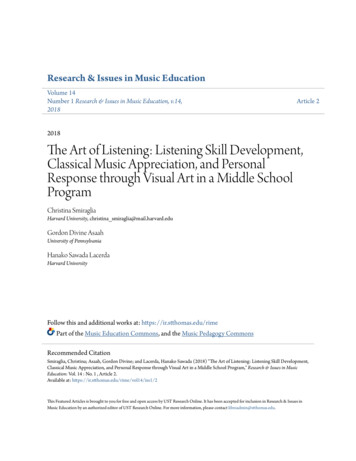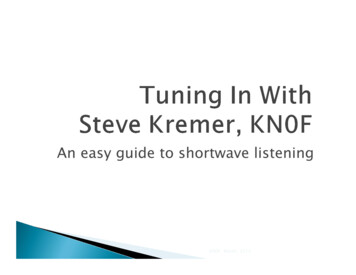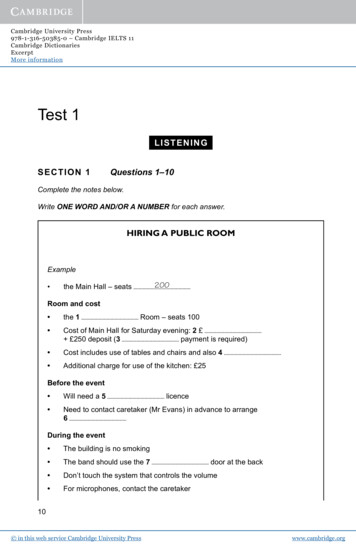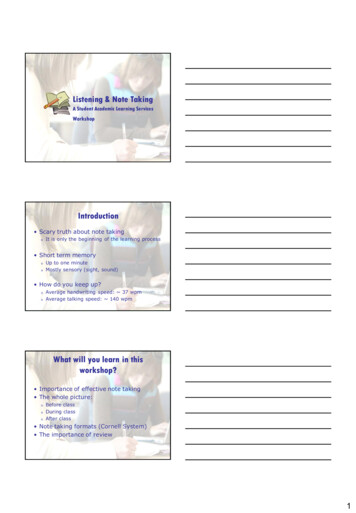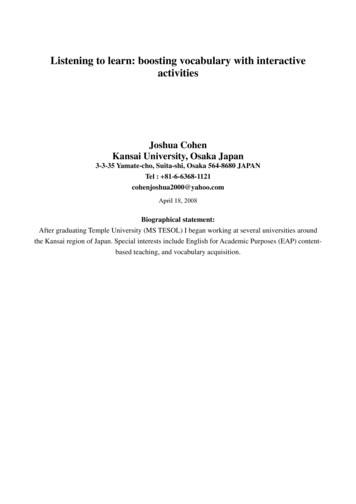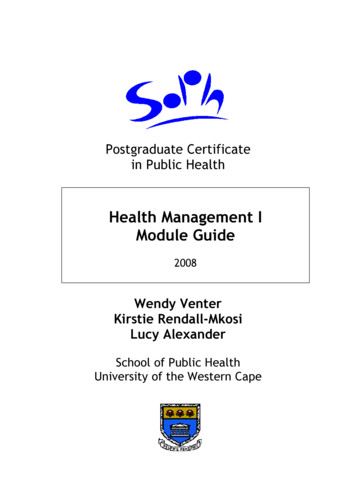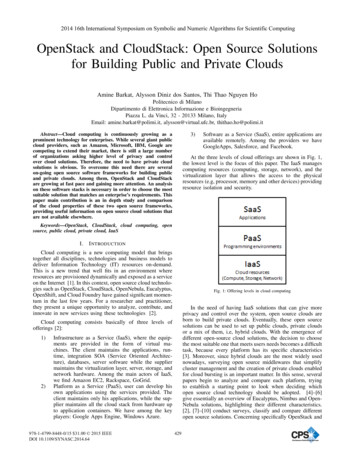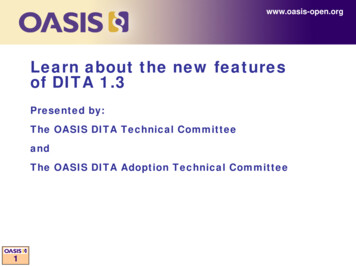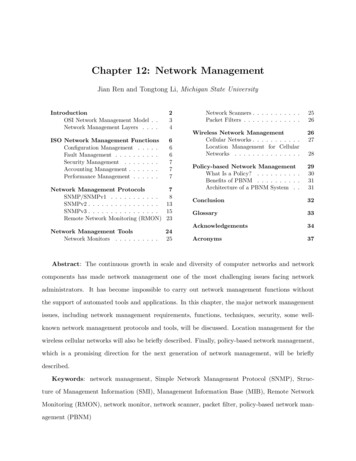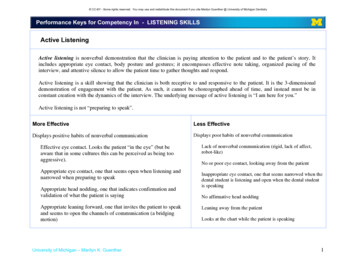
Transcription
CC-BY - Some rights reserved. You may use and redistribute this document if you cite Marilyn Guenther @ University of Michigan DentistryActive ListeningActive listening is nonverbal demonstration that the clinician is paying attention to the patient and to the patient’s story. Itincludes appropriate eye contact, body posture and gestures; it encompasses effective note taking, organized pacing of theinterview, and attentive silence to allow the patient time to gather thoughts and respond.Active listening is a skill showing that the clinician is both receptive to and responsive to the patient. It is the 3-dimensionaldemonstration of engagement with the patient. As such, it cannot be choreographed ahead of time, and instead must be inconstant creation with the dynamics of the interview. The underlying message of active listening is “I am here for you.”Active listening is not “preparing to speak”.More EffectiveLess EffectiveDisplays positive habits of nonverbal communicationDisplays poor habits of nonverbal communicationEffective eye contact. Looks the patient “in the eye” (but beaware that in some cultures this can be perceived as being tooaggressive).Appropriate eye contact, one that seems open when listening andnarrowed when preparing to speakAppropriate head nodding, one that indicates confirmation andvalidation of what the patient is sayingAppropriate leaning forward, one that invites the patient to speakand seems to open the channels of communication (a bridgingmotion)University of Michigan – Marilyn K. GuentherLack of nonverbal communication (rigid, lack of affect,robot-like)No or poor eye contact, looking away from the patientInappropriate eye contact, one that seems narrowed when thedental student is listening and open when the dental studentis speakingNo affirmative head noddingLeaning away from the patientLooks at the chart while the patient is speaking1
CC-BY - Some rights reserved. You may use and redistribute this document if you cite Marilyn Guenther @ University of Michigan DentistryReflective ListeningReflective Listening is verbal demonstration that the clinician is paying attention to the patient and to the patient’s story. It includesrepetition, paraphrasing and summarizing of the patient’s statements; it encompasses active use of the patient’s language, and it attempts tohighlight significant statements from the patient.Reflective listening then is more than simple reflection of patient utterances. It includes the reflective capacity of the clinician to perceivethe plot of the patient’s story. It is the skill that demonstrates understanding of the patient. It creates emphasis on various aspects of thepatient’s story and collects these aspects to form a perspective: a view of the patient. As necessary, this view is modified by patient inputuntil both the clinician and the patient feel that an appropriate image of the patient has been achieved. In its dynamic process, reflectivelistening establishes a partnership.The underlying message of reflective listening is “I hear you” and “We are working together.”More EffectiveLess EffectiveTo clarify, or to create emphasisTo clarify, or to create emphasisRepeating patient statementsParaphrasing patient statementsWith very few “output” statements from the patient, the clinician interrupts the patient andtakes over the interviewTo establish the patient’s story and to validatethe patient“I see that ”“I understand that”“It’s clear that”“It says in the chart that”“According to your medical and dental history ”Repeating clinician statementsParaphrasing clinician statementsSummarizing the patient’s statementsActively using the patient’s language in theabove techniquesActively engaging in a dialogue with the patientTo establish the patient’s story and to validate the patientWith very few output statements from the patient, making assumptions about the patient anddetermining conclusions from those assumptionsTaking a fragment of the conversation and running with it: If this, then that, so here!Demonstrating lack of active inquirySummarizing the clinician’s statementsActively using the clinician’s language and/or jargonActive engaging in a monologue with the patientUniversity of Michigan – Marilyn K. Guenther2
CC-BY - Some rights reserved. You may use and redistribute this document if you cite Marilyn Guenther @ University of Michigan DentistryEmpathic ListeningEmpathic Listening is the skill that demonstrates attention to the emotional aspects of the patient’s story, not just the facts of the matter. It includesintuitive cueing of feelings from the patient’s verbal and nonverbal messages, labeling of those feelings by mutual interaction of the clinician and thepatient, and establishing comprehension of the effect of these emotions on patient alliance (often referred to as patient compliance). In other words,developing an emotional understanding of the patient is an effective tool in diagnosis and treatment planning. (Ex. An elderly woman presents as verystressed over the loss of a third tooth in the past 2 months, and wonders whether a partial will be “worth it.”).Empathic listening actively acknowledges and accepts that the concerns, feelings, perceptions, and attitudes of the patient are real and important. Itvalidates the patient through caring affect and affirming words. It is nonjudgmental.The underlying message of empathic listening is “I understand” and “We will work together based on this understanding.”More EffectiveLess EffectiveVerbal acknowledgement of patient affectIgnoring all affect“You seem overwhelmed by all this information.”“You seem worried about your oral health.”“I notice you look upset when we talk about the number of appointmentsnecessary to complete your treatment.”“I see that you’re concerned about your symptoms and what they might mean.”It is not necessary to be right when offering the observation, just approximatelyon target. Because such an observation is intended as a lead, ensuingdiscussion with the patient will provide clarification. These statements aremeant to be spoken as “leads”, invitations for the patient to speak, not asdeclarations of the clinician’s opinions.Any statement that indicates valuing of and support for the patient’s perspective.“I see what you mean.”“I hear what you’re saying.”“I understand.”“I believe I can be helpful in treating your condition.”“I appreciate everything you’re already doing to deal with this condition.“(Being specific here provides positive reinforcement for patient ‘s healthpromoting behaviors.)Nonjudgmental attitudeCaring nonverbal behavior (ex. Eye contact, leaning forward, compassionatetouch, concerned facial expressions)University of Michigan – Marilyn K. GuentherDiscounting affect (“There’s nothing to be worried, upset, concerned,overwhelmed about.)”Making authoritative declarations of the patient’s affect (E.g., Youcertainly are the worrying type.)Inattentive silence while the patient is speaking.Attentive silence, but no verbal acknowledgement of the patient’sperspective.Stony silence followed by the expression of the attitude “Now let metell you what I think.”Judgmental facial expressionsAny statement that indicates dismissal of the patient’s perspective.No statements of concernNo statements of empathyNo statements of a willingness to helpNo positive reinforcement for patient’s health promoting behaviorsJudgmental attitudeNonverbal behavior indicating indifference or even rejection3
CC-BY - Some rights reserved. You may use and redistribute this document if you cite Marilyn Guenther @ University of Michigan DentistryScoring KeyStrongly agree (Skillfully done) Consistent use of More Effective behaviors Absence of Less Effective behaviorsAgree (Adequately done) A preponderance of More Effective behaviors over LessEffective behaviorsNeutral Approximately equal use of More Effective behaviors andLess Effective behaviorsDisagree A preponderance of Less Effective behaviors overEffective behaviorsStrongly disagree (Needs improvement) Absence of More Effective behaviorsMore Consistent use of Less Effective behaviorsNot DoneUniversity of Michigan – Marilyn K. Guenther4
CC-BY - Some rights reserved. You may use and redistribute this document if you cite Marilyn Guenther @ University of Michigan Dentistry
CC-BY - Some rights reserved. You may use and redistribute this document if you cite Marilyn Guenther @ University of Michigan Dentistry
CC-BY - Some rights reserved. You may use and redistribute this document if you cite Marilyn Guenther @ University of Michigan DentistryAcknowledgement BibliographyDesmond Joanne,Copeland Lanny R, M.D.,Communicating With Today's Patient, Josey-Bass, Inc.,2000.Kurtz Suzanne, Silverman Jonathan, Draper Juliet, Teaching and Learning Communication Skills inMedicine, Radcliffe Medical Press,1998.Silverman Jonathan, Kurtz Suzanne, Draper Juliet, Skills for Communicating with Patients, RadcliffeMedical Press, 1998.
University of Michigan – Marilyn K. Guenther 3 Empathic Listening Empathic Listening is the skill that demonstrates attention to the emotional aspects of the patient’s story, not just the facts of the matter. It includes intuitive cueing of feelings from the patient’s verbal and nonverbal messages, labeling of thos
